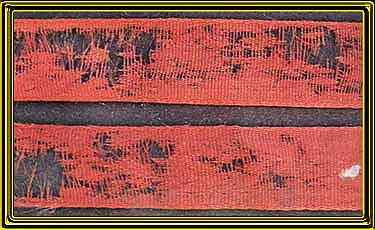
(The Silverfish)
This insect belongs to the Apterygota, wingless insects, and they are mostly very small and belong to four orders; 1. Thysanura. 2. Diplura. 3. Protura. 4. Collembola. We will be mainly concerned with the Thysanura. These are the three pronged bristle tails and contain the two commonest, Silverfish and Firebrat, the latter we will cover at a later stage as it is not known to damage textiles.It is probably about 300 million years ago that the first animal looking something like a silverfish saw the light of day. It was doubtless very widely distributed and occurred in enormous numbers, and it has been suggested that the primitive animals of this type may well have been the ancestors of all the different types of insects alive today. Some insects, including the silverfish, have remained more or less unchanged over long periods. Indeed it is likely that there were primitive insects of this type when the first fish went up onto the land, and that they crawled around the feet of dinosaurs, and they are still with us. Silverfish can in fact be regarded as living fossils comparable with the Coelacanth.
In spite of their antiquity, silverfish have succeeded in exploiting the new opportunities created by man. In southern Europe and in parts of Asia they live out in the open, under stones and in crevices, but elsewhere they are almost exclusively associated with human habitations - house, stables, outhouses and so on. Most people must have seen these small silvery insects run to shelter in the evening when the light is turned on in the kitchen, or may have found them in the bath or wash basin. They do not, as many believe, come up the drainpipe, but become trapped after sliding down the walls of the bath whilst searching for food during the night. They are particularly prevalent in kitchens and bathrooms for they require a high humidity or access to water.
Silverfish are pleasant animals which are easy to keep in captivity and they live for quite a long time, sometimes over 5 years. On the other hand they are not very prolific. Silverfish thrive on the tinniest scraps of food, they prefer starchy food but are quite able to digest cellulose, they also eat the dead members of their own kind.
Biology:
Size: These insects are about 1/4 inch long and silver coloured.
Habitat: Everywhere, especially where it is damp, as they require a high humidity.
Eggs: A female will only lay about 20 eggs in her lifetime, depositing them in cracks and crevices and the young resemble the adults, except in size, incomplete metamorphosis.
Sexual maturity: Usually attained after a period of about 6 months.
Food Preferences: Omnivorous.
Damage:
As stated earlier, silverfish can digest cellulose, therefore paper is at risk if it is left in a damp area:
Now where is that Penny Black...?
It's getting near Christmas, 2000 that is, and everybody is searching out the decorations and wrapping materials trying to save money, because you're certain that you bought too much last year..and I put it here somewhere...grunt.....groan....ahhh! here it is.
Sorry folks...the silverfish got there first..!
Back to main Textile Pests page

